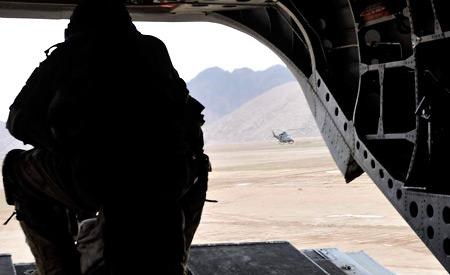by Tod Strickland Standing on the airfield, I marvelled at the wide puddles of water at my feet. After weeks of Kandaharis hoping for rain, it finally happened and for the past two weeks rain storms have been sweeping across the deserts surrounding Kandahar City and our home at the airfield.
Normally the air is filled with fine, talcum powder-like dust, but when the rain falls, the skies become clear and visibility improves dramatically. Where before it was impossible to make out the features on the mountain across from the airfield, now they are clear and distinct, as well as those on the mountains nearer the city. In short, it was a great day to be leaving the confines of Kandahar Air Field (KAF) for the relative austerity of a Forward Operating Base (FOB).
The Chinook helicopter, which was to move us there and back, came to a halt about 100 metres away. En masse, the chalk (military parlance for the group of us) walked out and boarded the back of the chopper, loading our weapons and checking our ear plugs as we were hit with the heavy rotor wash that comes from the big, dual-rotored machine. Sitting down quickly, we struggled to secure seat belts over ourselves, encumbered with flak-jacket, helmets, safety glasses and our load-carrying vests. Moments later we were airborne and lumbering across the sky heading for the FOB.
The Chinooks are great machines, and are fun to fly in. The back door remained open throughout the flight and gave us the opportunity to look out at where we had been. Flying low across the Reg desert waves of red sand and low grey-green scrub could be seen together with the occasional camel, and tire tracks from the ubiquitous Toyota Hilux trucks so much in use here. It was like watching a big-screen TV that only emitted a high-pitched hum, but the view was fantastic.
Occasionally the escort choppers popped into view, their distinct lines hazy in the heat mirages thrown off by the exhaust; the door-gunner and his machine gun keeping watch and ensuring the safety of passengers and crew alike. The difference between a 30-minute flight by Chinook and a four-hour road move in one of our Light Armoured Vehicles (LAVs) is incredible; with one you risk getting shot down (a relatively rare event given the escort choppers and door gunners) while with the other you face the threat of IEDs (improvised explosive devices).
There was so much to see and yet all too soon it ended, and we touched down in the hesco-walled FOB. Quickly the machine was emptied and airborne again while we former passengers tried to take in all that surrounded us, including the relative quiet of the Afghan countryside. A young sergeant with a very cheesy moustache smiled and directed us to the command post. Walking past the sarge I couldn’t help but wonder if his wife or girlfriend would let him keep the stache when he got home.
The FOB seemed to fit right into the Afghan countryside. Gravel, military vehicles, slightly scruffy soldiers, and mud seem to be the main features. Walking around, it quickly became apparent that the rain, which had seemed relatively harmless at KAF, was having significant impacts on life at the FOB. Front-end loaders were on the move, shifting gravel to the muddier spots, making the roads a little less quagmirish; troops were wearing over-boots in an effort to keep dry, and duck-boards that would have been more familiar in the trenches of World War I were making a comeback.
Walking around, I ran into two old friends from previous tours and life back with the Princess Patricia Canadian Light Infantry. Although I was there to find out what was happening in the area, the conversation quickly shifted and a cup of coffee appeared in my hand. Rather than talking work, we changed gears and talked about family and friends, life on KAF and what was happening back in Canada. With the rain threatening to make another appearance I was shown the living conditions, and became more than a little humbled at the relative luxury that I enjoy living on the airfield. Yet, the troops on the FOB were happy where they were and could not seem to imagine trading their relative freedom for the structure and regulations that at times typify KAF. Cutting the conversation short, one of my troops strode up and let me know that the chopper was coming back—“lift off in 10.” Shaking hands, and wishing each other good luck for the future, I headed back to the landing zone.
As our party gathered around a couple of LAVs, we quickly got dressed in our “battle-rattle” and prepared to re-board the Chinook that would carry us back to KAF. This time, the scenes of the desert were replaced by mud and walls of rural Afghanistan as we flew along a river heading toward KAF. The amount of water on fields, and even on roads, was incredible. It was also incredibly ironic, as the river we followed seemed to be almost bone dry.
All too quickly we banked hard to the right, and the familiar confines of KAF came into view. Touching down in almost the exact same spot we had left we walked down the ramp and cleared our weapons once we were out of the prop-blast. A light rain fell as I walked back to headquarters.
Lieutenant-Colonel Tod Strickland is Assistant Chief of Staff for Task Force 5-10, and member of the Princess Patricia Canadian Light Infantry, serving in Kandahar, Afghanistan.



